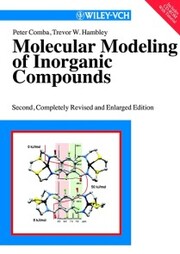-
Zusatztext
-
In many branches of chemistry, Molecular Modeling is a well-established and powerful tool for the investigation of complex structures. The second completely revised and enlarged edition of this highly recognized book shows how this method can be successfully applied to inorganic and coordination compounds.<br> The first part of the book gives a general introduction to Molecular Modeling, which will be of use for chemists in all areas. The second part discusses numerous carefully selected examples, chosen to illustrate the wide range of applicability of molecular modeling to metal complexes and the approaches being taken to dealing with some of the difficulties involved. While the general outline is similar to that of the first edition, many of the examples chosen for discussion reflect the changes of the past five years. In the third part, the reader learns how to apply Molecular Modeling to a new system and how to interpret the results. The accompanying software features 20 tutorial lessons based on examples from the literature and the book itself. The authors take special care to highlight possible pitfalls and offer advice on how to avoid them. Therefore, this book will be invaluable to everyone working in or entering the field.
-
-
Kurztext
-
In many branches of chemistry, Molecular Modeling is a well-established and powerful tool for the investigation of complex structures. The second completely revised and enlarged edition of this highly recognized book shows how this method can be successfully applied to inorganic and coordination compounds. The first part of the book gives a general introduction to Molecular Modeling, which will be of use for chemists in all areas. The second part discusses numerous carefully selected examples, chosen to illustrate the wide range of applicability of molecular modeling to metal complexes and the approaches being taken to dealing with some of the difficulties involved. While the general outline is similar to that of the first edition, many of the examples chosen for discussion reflect the changes of the past five years. In the third part, the reader learns how to apply Molecular Modeling to a new system and how to interpret the results. The accompanying software features 20 tutorial lessons based on examples from the literature and the book itself. The authors take special care to highlight possible pitfalls and offer advice on how to avoid them. Therefore, this book will be invaluable to everyone working in or entering the field.
-
-
Autorenportrait
- <p><strong>Peter Comba</strong> is Professor of Inorganic Chemistry at the University of Heidelberg, Germany. He obtained his diploma in chemistry from ETH and his PhD in 1981 from the University of Neuchatel, Switzerland. After postdoctoral positions at the Australian National University and the University of Lausanne and the habilitation at the University of Basel, he moved in 1992 to Heidelberg. He received the Humboldt South Africa Research Award in 2000 and had visiting professorships at the universities of Leiden, ANU, Pretoria, Brisbane and Osaka. His research includes theory and experiments in transition metal coordination and bioinorganic chemistry - molecular modeling, spectroscopy, thermodynamics, magnetochemistry, kinetics and mechanisms, synthesis and catalysis.<p><strong>Trevor Hambley</strong> is Emeritus Professor of Chemistry at the University of Sydney's School of Chemistry. His research interests include medicinal inorganic chemistry and targeted delivery of metal-based anticancer agents.
Detailansicht
Molecular Modeling of Inorganic Compounds
eBook
ISBN/EAN: 9783527612994
Umbreit-Nr.: 3836258
Sprache:
Englisch
Umfang: 337 S., 16.44 MB
Format in cm:
Einband:
Keine Angabe
Erschienen am 11.07.2008
Auflage: 3/2008
E-Book
Format: PDF
DRM: Adobe DRM


